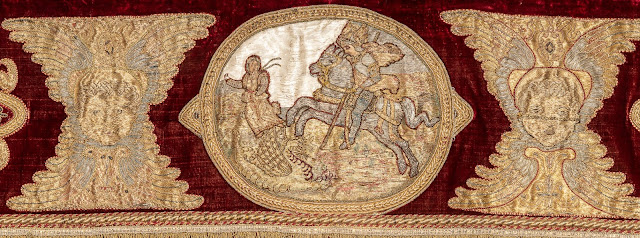That bit of historical trivia aside though, the colour of the liturgical vestments for the feast of Pentecost is, of course, red -- at least in the Western church. Paired with that colour are frequently symbols of the Holy Spirit, such as the symbol of the dove, or flaming symbols representing the tongues of fire that are said to have descended upon the apostles at that time:
And when the days of the Pentecost were accomplished, they were all together in one place: And suddenly there came a sound from heaven, as of a mighty wind coming, and it filled the whole house where they were sitting. And there appeared to them parted tongues as it were of fire, and it sat upon every one of them: And they were all filled with the Holy Ghost... (Acts 2:1-4)
Next we have a slightly earlier frontal dated to the last quarter of the sixteenth century. Unfortunately you are going to have to use your imaginations slightly as the photograph we have of this particular frontal was not particularly well done..
 |
| The IHS Christogram -- in the alternative "YHS" form. |
 |
| St. George |
This frontal is likewise made of velvet and in this case we likewise find a saint included -- in this instance, St. George. St. George is placed in the central medallion of the superfrontal (i.e. the upper portion of the antepnedium) but there are also a great number of images that are pertinent to Pentecost and the Holy Spirit, specifically the doves found on the superfrontal and, once again, symbols representing fire.





















